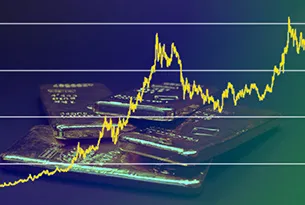As countries continue to create money out of thin air to dodge debt crises, where will this all end? And how can investors prepare? MoneyShow's Jim Jubak, also of Jubak's Picks, explores the likely scenarios.
So how does this end?
I don't mean the current Spanish debt crisis or even the Euro debt crisis. I think we know what the "solution" will be to that. And I don't even mean the US debt crisis or the Chinese debt crisis. I think we know what the "solutions" for those will be as well.
But what about the meta crisis? The one that's been created by the current round of "solutions." How does that end?
I'd suggest that we all brush up on Gresham's Law, the 16th-century description of what happens to strong currencies when they meet up with bad money. In a nutshell, Gresham's Law says that the bad currencies win. Figuring out what to do about that is important as investors head into era of bad money as far as the eye can see.
Creating New Money
I think it's clear by this point in the aftermath of the global financial crisis that all the various local crises have been "solved" to date by the creation of vast sums of money, essentially out of thin air, on the official balance sheets of central banks such as the Federal Reserve and the European Central Bank, and on the unofficial balance sheets of, say, China's banking system.
I think it's equally clear that, for all the talk about economic reforms creating growth, or austerity creating growth, or financial market confidence creating growth, that the most likely "solution" going forward is the continued creation of vast sums of money, essentially out of thin air.
It's still an open question if the "solution" will work. In the case of Spain, for example, the European Central Bank fixed the crisis for a while by giving banks access to €1 trillion in three-year loans in December and February.
But by late March, the crisis was back, and the yields on Spanish and Italian government bonds started to rise again. Now we're looking at another program of bond buying by the central bank to lower yields, or another program of three-year loans to banks to give them the money to buy bonds in order to lower yields.
To condense what I wrote in my April 13 column on the current state of the Spanish crisis, Spain and the Eurozone are likely to fall back on a series of increasingly desperate kludges by the European Central Bank, other global central banks, and finally the International Monetary Fund.
Each of those fixes would require that somebody print money—either the European Central Bank, the International Monetary Fund or some combination of the Federal Reserve, the Bank of Japan and the People's Bank of China. Print enough, and the immediate Spanish crisis goes away again, as bond yields sink and governments get more breathing space to propose economic reforms and budget cuts.
At some point, though, the bill for these solutions comes due. I hope that point comes after some semblance of economic order has returned to the Eurozone, and when growth has recovered in the United States and China.
But even if Spain—and Italy, Portugal, and Ireland—win back enough confidence to be able to sell bonds in the financial markets again, the world will still be looking at the bill for this crisis. And we'll still be looking at unsolved budget and balance-sheet problems in the United States and China.
Up Next: How Big is the Bill?...
|pagebreak|How Big Is the Bill?
The grand total depends on how many central banks we want to include in our reckoning.
At the least, we should count the balance sheets of national central banks. For example, the Banco de España, Spain's central bank, showed an increase in its balance sheet for net lending to €228 billion in March, from €152 billion in February. The March 2012 lending total was up from just €42 billion in March 2011.
Go up another level to the balance sheet of the European Central Bank. At the beginning of March, the European Central Bank's balance sheet hit a record €3.02 trillion (roughly $4 trillion). That was nearly one-third bigger than the German economy.
The only thing good about the rapid expansion of the European Central Bank's balance sheet is that it makes the Federal Reserve's balance sheet, at $2.9 trillion, look positively conservative.
Deleveraging those balance sheets will be extremely dangerous. Central banks will have to sell bonds and other assets back into the financial markets in order to reduce the size of their balance sheets. That will reduce the money supply and cut into growth.
At the same time, governments that haven't yet dealt with their outsize budget deficits and their own debt will have to raise taxes, cut spending, or both. The two-track effort, even if successful, will be a huge drag on national economies and on the total global economy.
However, I think we can assume, from the behavior of national governments and central banks during the crisis so far, that they will do all they can to put off any significant deleveraging.
Global Aging Isn't Helping
Yes, there will be budget cuts and/or higher taxes even in the United States, but as in the Eurozone debt crisis, each plan is likely to run far behind events. That's not surprising, since the post-Lehman Brothers financial crisis is running parallel to unprecedented global aging.
That demographic shift by itself would stress the budgets of every government in the world, because national budgets have been built on assumptions of a much younger world. National politicians will have a tough time staying ahead of demographic and fiscal trends.
As the Eurozone crisis has demonstrated over and over, politicians will do what they think is the minimum necessary to defuse any acute crisis while attempting to minimize the political pain. Even if the governments of the world gradually are forced to act by the markets and by the constraints of the real economy, any progress is likely to be very, very slow, and punctuated by crises in some part of the world.
What are the consequences? Here's where Gresham's Law comes in, both in its popular and in its more accurate forms.
The popular form goes: "Bad money drives out good." People tend to hold good money—money that isn't going to depreciate rapidly—and therefore remove it from circulation. They tend to use any readily available money, even if they don't trust its value in the long run, because in the short run, availability of the currency counts for more than its ability to hold value.
A more exact reading of Gresham's Law runs: "Bad money drives out good if the exchange rate is set by law." (During Gresham's lifetime in Tudor England, he had the repeated opportunity to observe what happened when the government tried to set the value of money by declaration.)
This part of Gresham's Law argues for the long-term failure of efforts to set the value of currencies by government decree. In our century, we don't do that by royal proclamation, but by central bank intervention.
What does all this mean practically? It means that we can expect the extreme pressure that has led countries to abandon strong currency policies to become irresistible over time.
Up Next: The Decision by the Swiss National Bank...
|pagebreak|The decision by the Swiss National Bank, for example, to link the franc to the euro to limit the pain that a strong currency was inflicting on national exporters is an example of things to come. The Swedish central bank, Sveriges Riksbank, faces similar pressure from exporters to depress the value of the krona.
It also means that such efforts aren't likely to succeed in the long term. As long as the Swiss and Swedish national budgets and deficits don't look like those of the Eurozone, there will be continued upward pressure on those currencies, and the central banks in those countries won't be able to indefinitely keep their currencies from appreciating.
It also suggests that efforts like those of Brazil to depress its currency also won't succeed in the long term, unless Brazil is willing to slap on currency restrictions that resemble those on the Chinese yuan.
That would be extraordinarily perverse, since the Chinese are moving with accelerating speed to ease controls on the yuan in order to make it into a global currency that would let China reduce its dependency on the dollar, euro, and yen.
In the long term, I don't know how this plays out—although I suspect the outcome is rather ugly, with the odds pointing toward another global financial and economic crisis not too far down the road, touched off by some combination of deleveraging of central banks, economic slowing in developed economies (especially the United States), and budget crises set off by the consequences of aging populations.
But in the medium term—which is the one that investors live in—Gresham's Law suggests that we can count on further appreciation of the sounder currencies of the world, despite attempts by central banks to depress the value of those currencies. That could well slow growth in economies such as Sweden, Canada, Australia, Brazil, and China, as those governments gradually lose the fight against currency appreciation.
For US-based investors, the appreciation in those currencies against the dollar could well make up for any underperformance of those strong-currency economies. (The same would hold true for investors based in the euro and the yen.)
In a world where growth from other sources looks as if it will be hard to find over the medium term, the continued appreciation of strong currencies is a source of gains that investors shouldn't overlook. (This same logic argues for portfolio exposure to gold and other commodities that go up in price as the dollar falls in value.)
One caveat, though. Any long-term trend in currencies or commodities will be punctuated with retreats that may tempt you to sell. If you think the long-term trends that I've described are indeed strongly in place, try to adopt a measured strategy that has you buying during those retreats instead of selling.



































